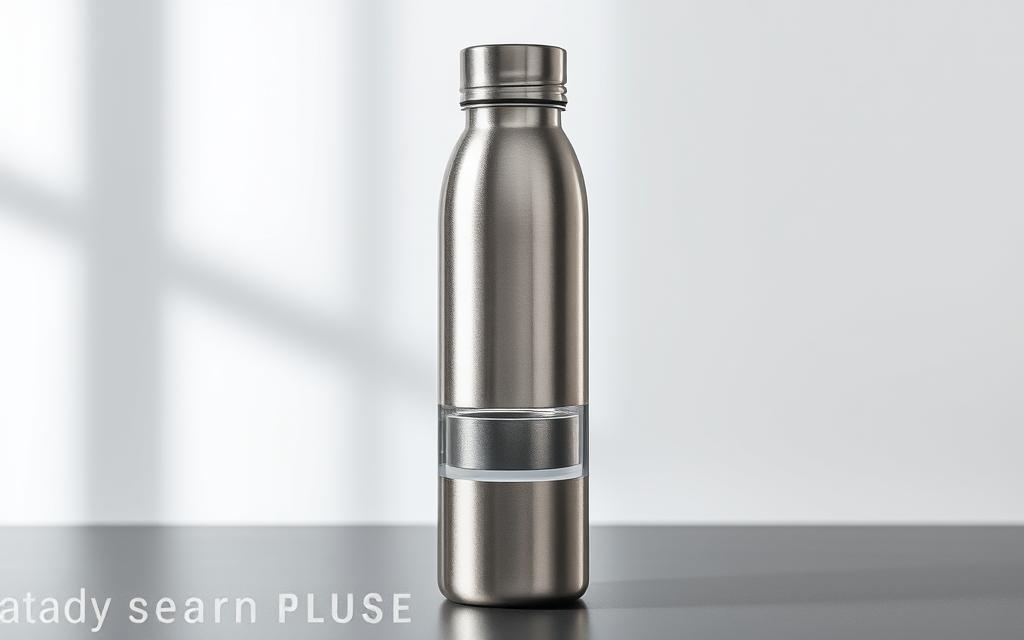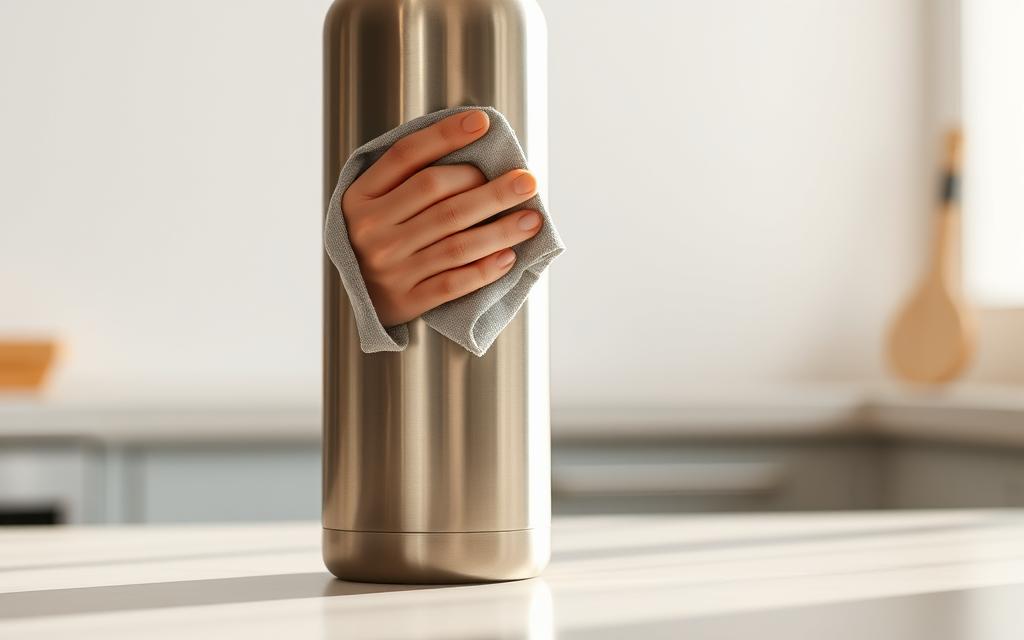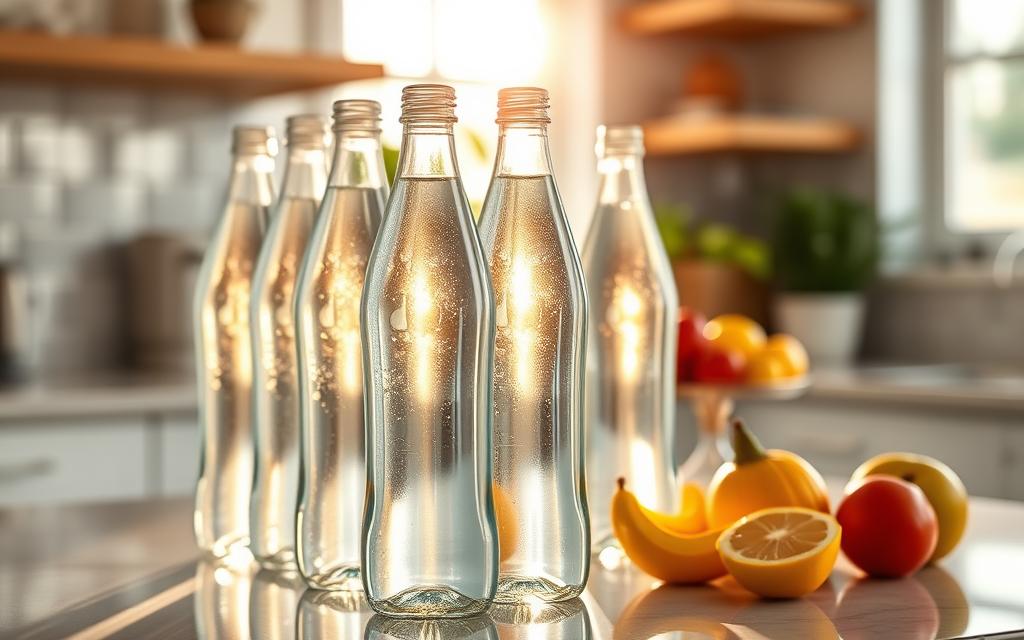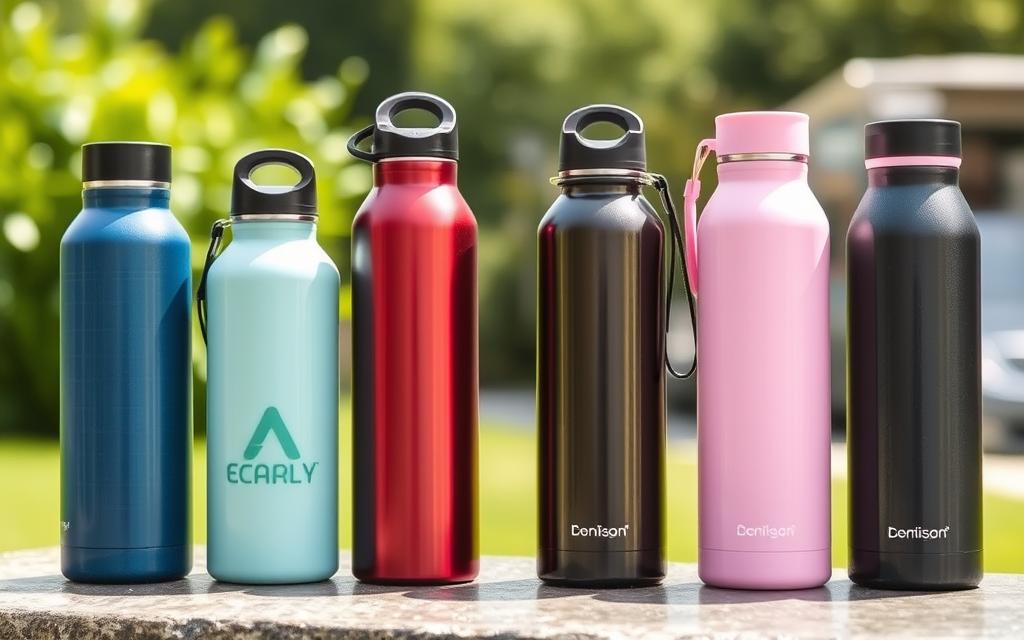Ever wondered why your stainless steel water bottle might taste odd or smell bad? It’s not just about staying clean. It’s about keeping your health safe and making your eco-friendly choice last longer.
Choosing a reusable water bottle is a big step against plastic waste. As someone who cares about health and the planet, I’ve found that taking good care of your stainless steel bottle is key. It keeps it working well and lasts longer.
In this guide, I’ll show you how to clean and care for your stainless steel water bottle. You’ll learn about daily cleaning and deep cleaning. This will help you keep your bottle in top shape.
Key Takeaways
- Regular cleaning prevents bacterial growth
- Different cleaning methods work for various bottle conditions
- Proper maintenance extends bottle lifespan
- Avoid harsh chemicals that can damage stainless steel
- Consistent care ensures fresh-tasting water
Understanding Stainless Steel Water Bottles
Stainless steel water bottles have changed how we stay hydrated and travel. They are a sustainable, durable way to keep drinks fresh and cool. As someone who loves eco-friendly hydration, I see why these bottles are so popular.

Benefits of Stainless Steel
Stainless steel water bottles have many benefits for health-conscious people. My top picks include:
- Naturally anti-microbial surface
- No harmful chemical leaching
- Exceptional durability
- Temperature retention capabilities
- Environmentally friendly alternative to plastic
Popular Brands of Stainless Steel Water Bottles
Knowing the top brands is key when it comes to stainless steel water bottle care. Using the best practices helps keep these products in top shape.
| Brand | Price Range | Key Features |
|---|---|---|
| Hydro Flask | $30-$50 | Excellent insulation, multiple colors |
| Yeti Rambler | $35-$45 | Thick walls, durability |
| Klean Kanteen | $25-$40 | Eco-friendly, lightweight design |
Common Uses for Stainless Steel Water Bottles
Stainless steel water bottles aren’t just for hiking or gym workouts. They’re great for many activities:
- Outdoor adventures
- Office and work environments
- School and campus life
- Travel and commuting
- Fitness and sports training
Understanding these uses shows why cleaning your stainless steel water bottle is so important. It ensures they last a long time.
Signs Your Bottle Needs Cleaning
Keeping your stainless steel water bottle clean is important. Over time, it may show signs that it needs a good cleaning. Spotting these signs early helps keep your bottle clean and your drinking experience better.
Visible Residue or Stains
Look out for visible residue when cleaning your bottle. Signs like mineral deposits, coffee rings, or stains mean it’s time for a deep clean. These marks come from:
- Hard water minerals
- Beverage remnants
- Inconsistent cleaning habits
Unpleasant Odors
A musty or stale smell means your bottle needs cleaning. Bacteria can cause these smells, often from:
- Bottles not being dried well
- Liquids left inside for too long
- Not cleaning often enough
Discoloration Over Time
Watch for color changes in your bottle. Yellowish or brownish tints can mean:
- Potential rust formation
- Mineral buildup
- Chemical reactions from drinks
| Sign | Potential Cause | Recommended Action |
|---|---|---|
| White/Gray Residue | Mineral Deposits | Vinegar Rinse |
| Persistent Odor | Bacterial Growth | Baking Soda Cleaning |
| Brown Stains | Coffee/Tea Remnants | Deep Scrub |
Pro tip: Regular inspection and prompt cleaning can prevent long-term damage to your stainless steel water bottle.
Daily Cleaning Routine
Keeping your stainless steel water bottle clean is key for health and durability. A daily cleaning routine is essential. I’ll show you how to keep your bottle in top shape for your next outing.
Quick Daily Rinse Technique
Start with a simple rinse every day. Here’s what to do:
- Empty the bottle completely
- Rinse with warm water
- Shake out excess moisture
- Allow to air dry with the cap off
DIY Cleaning Solution
For a deeper clean, try this homemade mix:
- Mix 1 teaspoon of white vinegar with warm water
- Swirl the mixture inside the bottle
- Let sit for 5 minutes
- Rinse thoroughly with clean water
Bottle Brush Essentials
A good bottle brush is vital for a clean bottle. Look for:
| Feature | Importance |
|---|---|
| Soft bristles | Prevents scratching |
| Long handle | Reaches bottom and corners |
| Flexible tip | Cleans curved surfaces |
Pro tip: Clean your brush after each use. Replace it every few months for best hygiene.
Deep Cleaning Your Stainless Steel Bottle
Keeping your stainless steel water bottle clean is more than just a quick rinse. Deep cleaning is key to keeping it hygienic and free from tough stains. I’ll show you how to care for your bottle so it stays in great shape.
Vinegar Soaking Method
Vinegar is a great tool for cleaning your stainless steel water bottle. Here’s a simple method I use:
- Add 2 tablespoons of distilled white vinegar
- Fill bottle halfway with warm water
- Let sit for 15 minutes
- Rinse thoroughly with clean water
Baking Soda Power Scrub
Baking soda is perfect for removing tough stains and bad smells:
- Sprinkle one teaspoon of baking soda inside the bottle
- Fill with warm water
- Gently shake to create a cleaning solution
- Let sit for 10 minutes
- Rinse completely with fresh water
Dishwasher Considerations
Dishwashers can be convenient, but they’re not always safe for stainless steel bottles. High temperatures and harsh detergents can damage your bottle. Always check the manufacturer’s advice before using the dishwasher.
Pro tip: Hand washing is usually the best way to clean your stainless steel water bottle.
Best Tools for Cleaning
Keeping your stainless steel water bottle clean is key. It’s not just about looks; it’s about keeping it safe and working well. Here are my top picks for cleaning your bottle the right way.
Bottle Brushes: Your Essential Cleaning Companion
Water bottle brushes are a must-have for cleaning. They have:
- Long, flexible handles for reaching deep inside bottles
- Soft bristles that prevent scratching delicate surfaces
- Narrow designs perfect for tight bottle necks
Microfiber Cloths: The Finishing Touch
Microfiber cloths are great for stainless steel water bottle care. They give a streak-free finish and gently remove stubborn water spots. Use them for both inside and outside cleaning.
Eco-Friendly Cleaning Agents
Go for cleaning solutions that are good for your bottle and the planet. Natural cleaners like white vinegar and baking soda are excellent for deep cleaning without harsh chemicals.
Pro tip: Always choose cleaning tools made for stainless steel to keep your bottle looking and working great.
Maintaining Your Bottle’s Appearance
To keep your stainless steel water bottle looking great, you need more than just a quick clean. It’s important to take care of it properly. Here are some tips to help you keep your bottle clean and shiny.
Preventing Scratches and Dents
Protecting your bottle’s outside is the first step. Here are some tips to avoid damage:
- Avoid dropping your bottle or placing it in areas with high impact risk
- Use protective sleeves or carrying cases for extra protection
- Store your bottle away from hard surfaces that could cause scratching
Thorough Cap and Lid Care
Don’t forget to clean your bottle’s cap and lid. Here’s a simple way to keep them clean:
| Cleaning Method | Frequency | Benefits |
|---|---|---|
| Vinegar Soak | Weekly | Removes bacteria and eliminates odors |
| Baking Soda Scrub | Bi-weekly | Deep cleans and removes stubborn residue |
Smart Storage Solutions
Storing your bottle right is key. Make sure to:
- Completely dry your bottle before storing
- Keep it in a cool, dry place
- Store it with the lid off to avoid moisture
Pro tip: Never store your bottle in direct sunlight or extreme temperatures, as this can damage its finish and compromise its integrity.
Eliminating Bad Odors
Stainless steel water bottles are great for staying hydrated, but they can get smelly. To clean them well, you need special methods. These methods get rid of bad smells without harming the bottle.
Odors come from things like coffee, tea, protein shakes, or when you store them for a long time. I have some tips to keep your bottle smelling fresh and clean.
Baking Soda: The Natural Deodorizer
Baking soda is great for fighting off bad smells. It’s a natural cleaner for stainless steel water bottles.
- Mix 1-2 tablespoons of baking soda with warm water
- Fill your bottle completely with the solution
- Let it sit overnight
- Rinse thoroughly in the morning
Vinegar Rinse for Deep Cleaning
White vinegar is amazing at getting rid of strong smells and killing bacteria.
- Create a solution of equal parts water and white vinegar
- Pour into the bottle
- Let it sit for 15-20 minutes
- Rinse completely with clean water
Essential Oils for Freshness
Essential oils can make your bottle smell nice. They offer a natural, refreshing scent.
| Essential Oil | Cleaning Benefit |
|---|---|
| Lemon | Antibacterial and fresh scent |
| Tea Tree | Strong antimicrobial properties |
| Lavender | Gentle cleaning and calming aroma |
Pro tip: Add 2-3 drops of your preferred essential oil after cleaning for a subtle, fresh fragrance.
Preventing Rust and Corrosion
Keeping your stainless steel water bottle from rust and corrosion is key. It helps keep the bottle in good shape for longer. Knowing how to care for your stainless steel water bottle is important.
Understanding Stainless Steel Properties
Stainless steel has a special layer of chromium that fights off corrosion. This layer makes the material resistant to rust and bacteria. By learning how to clean and maintain your bottle, you can keep this layer strong.
- Chromium creates a self-healing protective layer
- Resistant to microbial growth
- Naturally prevents oxidation
Proper Drying Techniques
Moisture is a big problem for stainless steel water bottles. After washing, I dry my bottle carefully. Here’s how:
- Use a clean microfiber cloth to remove all water droplets
- Air dry the bottle upside down on a clean dish rack
- Ensure the cap and lid are completely dry before reassembling
Avoiding Harsh Chemicals
To keep your bottle safe, avoid harsh cleaners. Chlorine bleach, abrasive cleaners, and metal polishes can harm the chromium layer. Use gentle cleaners like white vinegar, baking soda, or mild dish soap instead.
Pro tip: Always rinse thoroughly and dry completely after cleaning to prevent corrosion.
When to Replace Your Bottle
Stainless steel water bottles are great for staying hydrated. But, they don’t last forever. Knowing when to replace them is key for your health and performance.
Using the right cleaning tips can make your bottle last longer. But, some signs show it’s time for a new one.
Signs of Wear and Tear
Over the years, I’ve learned a few signs that mean it’s time for a new bottle:
- Deep scratches or dents that weaken the bottle
- Stinky smells that won’t go away after cleaning
- Rust or corrosion spots
- Broken threads or seals
Lifespan of Stainless Steel Bottles
How long your bottle lasts depends on how well you take care of it. A bottle that’s well-kept can last 5-10 years. Several things affect its lifespan:
- How often you use it
- How regularly you clean it
- Where you store it
- The quality of the bottle when you bought it
Eco-Friendly Disposal Options
When it’s time to get rid of your bottle, choose eco-friendly ways:
- Recycle it through local metal recycling programs
- Give it to outdoor or camping groups
- Use it for storing things that aren’t drinks
“A responsible approach to replacement ensures minimal environmental impact.” – Sustainability Expert
Pro tip: Always check with local recycling centers about specific stainless steel recycling guidelines in your area.
Additional Tips for Long-lasting Use
Maintaining stainless steel water bottles needs careful attention. They are very durable but have special care needs. This helps them last longer and work better. Here are some key tips to keep your bottle in great shape.
Microwave: A Definite No-Go
First, never microwave your stainless steel bottle. These bottles are made of metal, which can cause sparks. This can damage both the bottle and your microwave. Stainless steel also reflects microwaves, making it unsafe and not effective for heating.
Temperature Considerations
Extreme temperatures can harm your bottle. Here are important tips for keeping your stainless steel bottle in good shape:
- Avoid exposing the bottle to extremely hot or cold environments
- Do not leave your bottle in freezing car temperatures
- Keep away from direct sunlight for extended periods
- Let hot liquids cool slightly before pouring into the bottle
Understanding Bottle Limitations
Every stainless steel water bottle has its own limits. Some bottles are not designed for carbonated beverages or acidic drinks. Always check your manufacturer’s guidelines to know:
- Maximum temperature tolerance
- Recommended cleaning methods
- Compatibility with different types of liquids
- Specific care instructions
By following these tips, your stainless steel water bottle will stay a trusted friend for hydration. It will stay clean and functional for many years.
Conclusion: Caring for My Stainless Steel Water Bottle
Keeping your stainless steel water bottle clean is more than a chore. It’s about taking care of your health and the planet. By following the tips we’ve shared, your bottle will stay in top shape for many years.
Following simple care steps is key. Regular cleaning stops bacteria and keeps your bottle smelling fresh. Using a stainless steel bottle helps cut down on plastic waste, which is great for our planet.
By taking good care of your bottle, you’re doing more than just keeping it clean. You’re also making a statement for the environment. Every time you clean and store your bottle right, you’re helping to make the world a better place.
I urge you to make these habits a part of your daily life. A well-cared-for stainless steel water bottle is more than just a container. It’s a symbol of your commitment to health and the environment. Let’s keep making choices that are good for us and the planet.



